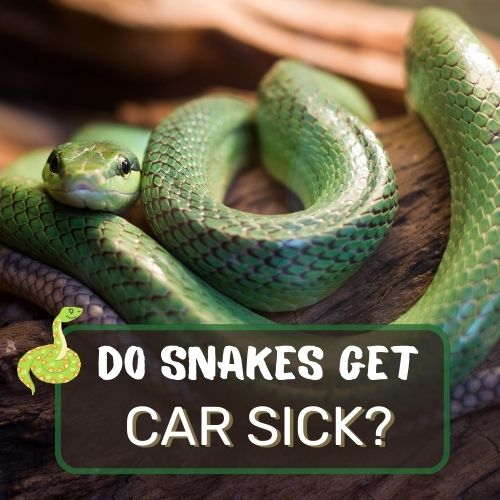
In this article, we delve into the fascinating world of snakes and their surprising susceptibility to motion sickness during car rides.
We will explore the signs and symptoms that indicate car sickness in snakes, shedding light on how these creatures react to the motion and movement of a moving vehicle.
Additionally, we’ll uncover the factors that contribute to their discomfort, including temperature variations, light and sound levels, and the role of stress and anxiety.
Providing valuable insights for snake owners, we offer essential tips for safe snake transportation, proper handling and positioning techniques, and guidance on post-travel monitoring and care.
Join us as we unravel the mysteries of snakes and car sickness, ensuring your scaly companions travel with ease and comfort!
Table of Contents
- 1 Answer On Do Snakes Get Car Sick?
- 2 Signs and Symptoms of Car Sickness in Snakes
- 3 Factors that Contribute to Car Sickness in Snakes
- 3.1 Motion and movement: How the snake’s body reacts to the car’s motion
- 3.2 Temperature: How variations in temperature can affect a snake’s well-being during travel
- 3.3 Light and sound: The impact of light and sound levels on a snake’s comfort during travel
- 3.4 Stress and anxiety: How stress and anxiety can exacerbate car sickness in snakes
- 4 Preventing Car Sickness in Snakes
- 4.1 Preparing the snake for travel: Proper handling and acclimation techniques
- 4.2 Creating a comfortable travel environment: Controlling temperature, light, and sound levels
- 4.3 Calming techniques: How to keep the snake calm and reduce stress during travel
- 4.4 Proper feeding and hydration before travel: Ensuring the snake is not hungry or dehydrated
- 5 3 Tips for Safe Snake Transportation
- 5.1 Choosing the right carrier: Factors to consider when selecting a carrier for snake transportation
- 5.2 Securing the carrier: Proper methods to secure the carrier in the car to ensure safety
- 5.3 Handling and positioning the snake in the carrier: Best practices for positioning the snake in the carrier to minimize discomfort
- 6 Monitoring and Caring for a Snake After Travel
- 6.1 Observing for signs of sickness: What to look out for after travel to ensure the snake is not experiencing any health issues
- 6.2 Providing necessary care: Steps to take if the snake does show signs of car sickness or illness
- 6.3 Consulting a veterinarian: When to seek professional help if the snake’s condition worsens
- 7 FAQ
- 8 Conclusion
Answer On Do Snakes Get Car Sick?
Snakes can experience car sickness, similar to some other animals. The motion and vibration of a moving car can be disorienting for them, leading to signs of distress such as restlessness, vomiting, or changes in behavior. It is important for snake owners to be aware of these potential symptoms and take preventive measures to create a comfortable and secure travel environment for their scaly companions.
Choosing the right carrier, securing it properly in the car, and providing a calm atmosphere can help minimize the likelihood of car sickness in snakes.
Additionally, post-travel monitoring and proper care are crucial to address any health issues that may arise during the journey.
Signs and Symptoms of Car Sickness in Snakes

When it comes to taking our slithery friends on road trips, we might wonder, “Can snakes get car sick?”
Surprisingly, the answer is yes!
Just like humans and some other animals, snakes can also experience motion sickness while traveling in a car.
But how do we know if our scaly companions are feeling under the weather during these journeys? Let’s take a closer look at the signs and symptoms of car sickness in snakes.
Common signs that indicate a snake may be experiencing car sickness
- Unusual behavior: If you notice your snake acting restless or agitated during car rides, it could be a sign of car sickness. They might become more active or attempt to escape from their enclosure.
- Vomiting: Just like humans, snakes might regurgitate their food or produce an excessive amount of saliva when they are feeling nauseous.
- Head movements: Keep an eye on your snake’s head movements. Frequent bobbing or swaying could indicate discomfort.
- Changes in color: A stressed snake might exhibit changes in skin color. For example, it might become paler or darker than usual.
How to identify these signs during travel
During a road trip, make sure to secure your snake’s enclosure properly to ensure their safety. Observe their behavior closely while driving.
If your snake starts displaying any of the mentioned signs, it’s essential to take immediate action.
- Pull over: If you notice your snake behaving unusually or showing signs of distress, find a safe place to pull over. This will allow you to check on your scaly friend and provide necessary care.
- Temperature regulation: Snakes are ectothermic, meaning they rely on the environment to regulate their body temperature. Ensure that the car temperature is comfortable for them during the trip.
Possible causes of car sickness in snakes
The exact reasons behind car sickness in snakes are not entirely understood, but several factors could contribute to their discomfort:
- Motion sensitivity: Snakes have a unique anatomy and are highly sensitive to motion changes. The movement of a car can be disorienting for them.
- Stress and anxiety: Traveling can be stressful for snakes, especially if it involves a bumpy ride or loud noises.
- Visual stimulation: Snakes rely on visual cues to navigate their surroundings. The constant movement outside the car windows might confuse them.
Factors that Contribute to Car Sickness in Snakes

Understanding the factors that contribute to car sickness in snakes can help us take better care of our scaly companions during travel. Let’s explore some key elements that play a role in their discomfort.
Motion and movement: How the snake’s body reacts to the car’s motion
Snakes are adapted to move in a unique serpentine manner. The constant motion and vibration of a moving car can be disorienting for them, leading to motion sickness.
Their specialized inner ear structures may not handle the changes in motion as well as other animals, making them susceptible to feeling queasy during car rides.
Temperature: How variations in temperature can affect a snake’s well-being during travel
As ectothermic creatures, snakes rely on external heat sources to regulate their body temperature. Fluctuations in temperature within the car can stress them out and worsen their car sickness.
Ensuring a stable and comfortable temperature within the car’s enclosure is crucial to their well-being.
Light and sound: The impact of light and sound levels on a snake’s comfort during travel
Snakes are sensitive to light and sound, and these factors can significantly affect their stress levels.
Bright lights or loud noises in the car can be distressing for snakes, contributing to their discomfort and increasing the chances of car sickness.
Stress and anxiety: How stress and anxiety can exacerbate car sickness in snakes
Traveling can be stressful for snakes, especially if it involves being moved from their familiar environment. Stress and anxiety can weaken their immune systems and make them more prone to motion sickness.
Ensuring a calm and relaxed atmosphere during travel is essential to keep car sickness at bay.
Preventing Car Sickness in Snakes

Taking the necessary precautions and following some simple practices can help prevent car sickness in snakes and make their travel experience much more pleasant.
Preparing the snake for travel: Proper handling and acclimation techniques
Before embarking on a road trip, familiarize your snake with its travel enclosure. Gradually introduce them to the travel container in a stress-free environment, allowing them to explore and get comfortable with it.
Proper handling and gentle interaction can help reduce anxiety before the journey.
Creating a comfortable travel environment: Controlling temperature, light, and sound levels
Maintain a steady and comfortable temperature within the car to avoid stressing your snake. Use appropriate bedding and substrates to ensure their enclosure feels familiar and secure.
Dimming the lights and minimizing loud noises can also help create a calming environment for them.
Calming techniques: How to keep the snake calm and reduce stress during travel
During the journey, avoid sudden movements or disturbances that could startle your snake. Speak softly and provide reassurance to keep them at ease.
Covering their enclosure partially can create a sense of security and further reduce stress.
Proper feeding and hydration before travel: Ensuring the snake is not hungry or dehydrated
Ensure your snake has been fed and hydrated adequately before the trip. Hungry or dehydrated snakes may experience more discomfort during travel.
However, avoid feeding them a large meal right before traveling, as this may lead to digestion issues.
By considering these factors and taking preventive measures, we can make car travel a more enjoyable experience for our snake companions and reduce the likelihood of car sickness.
Remember, a well-prepared and stress-free journey ensures a happier and healthier snake.
3 Tips for Safe Snake Transportation

Transporting a snake safely during car rides is crucial to their well-being. Here are some tips to ensure a comfortable and secure journey for your scaly friend.
Choosing the right carrier: Factors to consider when selecting a carrier for snake transportation
Opt for a carrier that is well-ventilated, secure, and appropriately sized for your snake. A carrier that is too large may allow for excessive movement, leading to discomfort, while one that is too small may cause stress.
Ensure the carrier has a secure locking mechanism to prevent accidental openings.
Securing the carrier: Proper methods to secure the carrier in the car to ensure safety
During travel, place the carrier on the floor of the car, ideally behind the front seats. Secure the carrier with a seatbelt or other restraints to prevent it from shifting during sudden stops or turns.
Keeping the carrier stable helps minimize motion disturbances that could lead to car sickness.
Handling and positioning the snake in the carrier: Best practices for positioning the snake in the carrier to minimize discomfort
Position your snake in the carrier carefully, ensuring it has enough space to move around comfortably. Avoid overcrowding or stacking multiple snakes together.
Provide a soft substrate for them to rest on and add some familiar items from their enclosure, such as hides or branches, to create a sense of security.
Monitoring and Caring for a Snake After Travel

After the journey, it’s essential to monitor your snake for any signs of distress or illness. Here’s what you should do:
Observing for signs of sickness: What to look out for after travel to ensure the snake is not experiencing any health issues
Once you reach your destination, keep a close eye on your snake for any unusual behavior or signs of car sickness. Look for changes in appetite, breathing patterns, or any visible signs of stress, such as excessive hiding or restlessness.
Providing necessary care: Steps to take if the snake does show signs of car sickness or illness
If you notice any signs of car sickness or distress, provide your snake with a calm and quiet environment to recover. Ensure they have access to fresh water and a suitable temperature to regulate their body.
Avoid handling them excessively and allow them time to rest and recuperate.
Consulting a veterinarian: When to seek professional help if the snake’s condition worsens
If your snake’s condition does not improve or worsens after travel, it’s crucial to seek professional veterinary help.
A reptile veterinarian with experience in snake care can properly diagnose any health issues and recommend appropriate treatment.
By following these tips for safe snake transportation and providing attentive post-travel care, you can ensure a smooth and enjoyable journey for your scaly companion.
Remember, a well-prepared and cared-for snake will be ready for the next adventure!
FAQ
Do snakes vomit when stressed?
Yes, snakes can vomit when they are stressed. Stress can disrupt their digestive system, leading to regurgitation of their food. It is essential to minimize stress for your snake to maintain their overall well-being.
Is it normal for snakes to throw up?
While occasional regurgitation can happen for various reasons, it is not normal for snakes to throw up regularly. Frequent vomiting may indicate an underlying health issue, and you should consult a veterinarian if it persists.
How do you know if a snake is upset?
Signs of a stressed or upset snake include restlessness, hissing, defensive postures, rapid breathing, and refusing to eat. Observing changes in their behavior can help you identify when your snake might be feeling uneasy.
Conclusion
In this comprehensive article, we explored the intriguing question of whether snakes can get car sick. We learned that, like many animals, snakes can indeed experience motion sickness during car rides.
Recognizing the signs and symptoms of car sickness in snakes is crucial for ensuring their well-being during travel.
We discussed the factors that contribute to car sickness in snakes, such as motion sensitivity, temperature variations, and stress.
Implementing preventive measures, such as proper carrier selection, securing the carrier in the car, and creating a comfortable environment, can significantly reduce the chances of car sickness.
After travel, monitoring your snake’s health and providing necessary care are essential to address any potential issues that may arise during the journey.
Consulting a veterinarian with reptile expertise is vital if your snake shows signs of illness or distress.
As responsible snake owners, understanding and addressing car sickness in snakes can lead to happier and healthier travel experiences.
By following the tips and guidelines presented here, you can create a safe and enjoyable journey for your scaly companions. Remember, a well-cared-for snake is a content and adventurous companion!




0 Comments